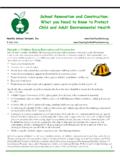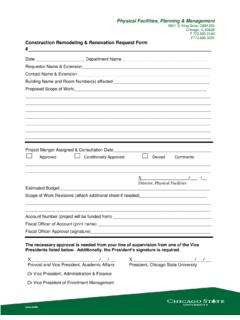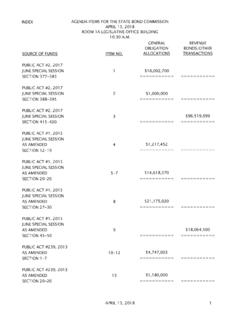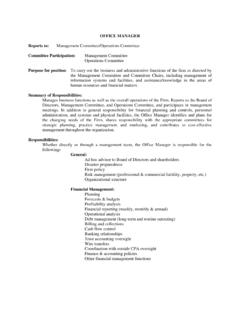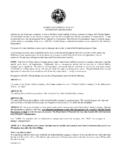Transcription of GUIDELINES FOR RENOVATION AND/OR …
1 JANUARY 1993 ADMINISTRATIVE SECTION GUIDELINES FOR RENOVATION AND/OR CONSTRUCTION OF BUILDINGS (WITH AND WITHOUT LITURGICAL SPACE) Steps to be Followed at the Steps to be Followed at theParish Level Diocesan Level 1. Prior to any public consultation with the parishioners concerning construction/ RENOVATION , the pastor is to send a letter to the bishop seeking his permission to begin a project of RENOVATION AND/OR construction. Within the letter, the pastor must give the bishop the basic information of his proposal. A. The bishop will respond to the pastor's letter.
2 If the bishop grants permission, then the Building and Properties Of-fice will set up an appointment with the pastor and present him with a packet of materials. 2. After consulting with his parish pastoral and finance councils the pastor will submit a Project and Financial feasibility document to the bishop's office . B. The Feasibility Document will be reviewed by the Diocesan Finance office as well as the Diocesan Building and Properties office who will make recommendations to the bishop.
3 This step may entail several revisions. C. If the plans call for a new church, the bishop will consult with his Presbyteral Council and neighboring pastors concerning the feasibility of construction of a new church (Canon 1215). After receiving their recommendations, the bishop will give permission to proceed to the next step. B-1 JANUARY 1993 ADMINISTRATIVE SECTION 3. At this point, the pastor is to request a meeting with the bishop or his representative as well as the Diocesan Art and Environment Committee to discuss in detail the proposal with representatives of Parish Council.
4 D. The bishop or his representative as well as the Art and Environment Committee will meet with the pastor and parish building committee to discuss the details of the project. 4. For extensive RENOVATION or construction of new liturgical space, a qualified liturgical consultant should be employed by the parish and is to meet with the parishioners, the members of the Liturgical Art and Environment Committee of the diocese, as well as any proposed architects. 5. The Diocesan Liturgical Art and Environment Committee will present workshops to the parish on elements of liturgy and liturgical space and design.
5 6. The parish building committee in conjunction with the pastor will then interview architects and make its recommendations to the bishop. E. The bishop, in consultation with the pastor, will approve the architect for the project. 7. Preliminary drawing of project will be sent to the diocese for review. F. Preliminary drawings of the proposed project will be reviewed by the bishop, the Building and Property office , as well as the Liturgical Art and Environment Committee of the diocese.
6 Recommendations in writing will be submitted to the pastor, and architect for further modification and B-2 JANUARY 1993 ADMINISTRATIVE SECTION changes. 8. The architect will submit to the Building and Property office the design, development drawings, and specifications of the project. G. Any difference of the recommendations by the diocese and that, which the pastor, the building committee and architect proposed, will be settled by the bishop. 9. Final drawings of the proposed project will be sent to the diocese for review by the bishop.
7 H. Final drawings of the proposed project will be reviewed by the Diocesan Liturgical Art and Environment Committee. Their recommendations will be made known to the bishop. The bishop will give approval to the final drawings. 10. The preparation of bids are to be done by the architect. Bids will then be taken on project. After bids from contractors have been received, the bids will be reviewed by the pastor and architect and their recommendation will be sent to the bishop.
8 I. The bishop, after consulting with the pastor, architect, buildings and properties office of the diocese, will select the contractor. 11. The construction contract will be prepared by the architect and sent to the diocese for approval. J. The construction contract will be reviewed by the diocesan Building and Property office as well as the diocesan lawyer.
9 The bishop will approve the contract and either he or his representatives will sign it. B-3 JANUARY 1993 ADMINISTRATIVE SECTION Notes: 1. Each step done at the parish level requires a letter from the bishop authorizing the proceeding to the next step. 2. All legal contracts arising from a RENOVATION or construction project must be signed by the bishop or his duly appointed representative. 3. Provisions need to be made in any RENOVATION or construction project for access by handicapped. 4. The bishop will send on an annual basis to all parishes, a letter outlining the RENOVATION and building GUIDELINES of the diocese. 5. The bishop will determine which buildings are considered to contain liturgical space and adjust the steps for those buildings without liturgical space.
10 B-4

